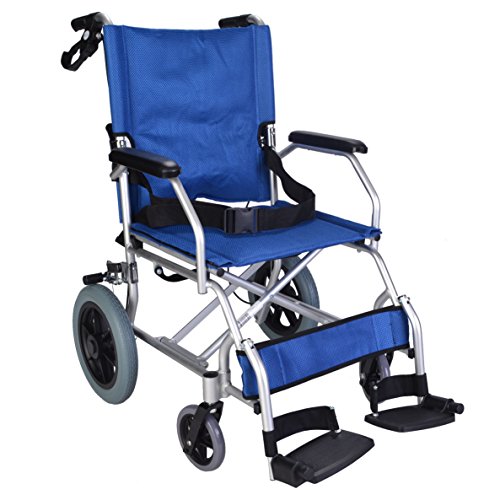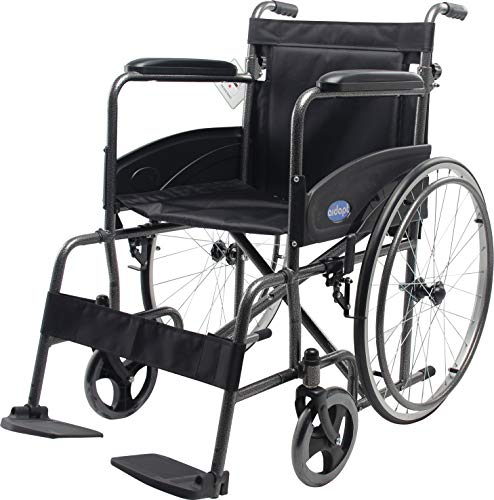The Unknown Benefits Of Wheelchair With Folding Arms
페이지 정보

본문
 Wheelchair With Folding Arms
Wheelchair With Folding Arms A wheelchair that has arms that fold provides increased flexibility and comfort. This feature allows the chair to be folded horizontally, reducing its size and making it easier to transport and store in vehicles.
A wheelchair that has arms that fold provides increased flexibility and comfort. This feature allows the chair to be folded horizontally, reducing its size and making it easier to transport and store in vehicles.Also, many of these wheelchairs include detachable, swing-away footrests with elevating footrests padding breathable nylon upholstery, and 8" x 1" solid front caster wheels that provide smooth and durable gliding over the majority of surfaces.
Vertical Folding
In order to ensure safety and comfort, wheelchairs are constructed with various features. For instance, they usually have an adjustable lumbar support. This allows the user to change the support's height so that it is more in line with their spine which can help ease pain from pressure on different areas of their body, including the coccyx, spine and lower back.
Another feature common to wheelchairs is the ability to change between manual and power mode. This can be done by lifting a lever located near the rear wheels. This puts the chair into manual mode, which means that it will not be powered by the motors, but is more maneuverable. To power the chair, simply move the lever downwards from the wheelchair.
Non-folding chairs are typically constructed with sturdy frames that provide high stability and durability. This is important because these types of chairs can be used for long periods of time, which is why they must be able to stand up to many years of wear and tear. These chairs are a great option for people who require wheelchairs that can carry the weight of a large amount.
The disadvantage of models that do not fold is that they take up more space in cars than folding models. This can be a problem for those who do not have access to a vehicle that can accommodate a wheelchair in its trunk. Additionally the weight of a folding wheelchair can be a problem for caregivers to lift and transport.
Folding wheelchairs are an excellent alternative for those who need to move chairs frequently. They typically have an elongated frame that can be collapsed which reduces their size and makes them easy to transport in a car. They also tend to be lighter than those that do not fold and can make them easier for caregivers to lift and move.
The invention described hereinafter provides a vertically-foldable wheelchair for elderly wheelchair that includes an elastomeric stop assembly. The stop assembly consists of a pair of side frame assemblies, each mounted rotatably to the upper frame member and occupying a first steady position on one side of a linkage assembly's centerline. The linkage assembly is biased toward the first stable position and is sufficiently resilient to retain the side frame assemblies in the deployed condition until the occupant selectively-manipulates the linkage assembly.
Horizontal Folding
This wheelchair type folds horizontally when stowed, which reduces the size of the platform and makes it easier to fit in the vehicle. It is the most popular chair for those who have to be able to maneuver their chairs into vehicles with roofs that are low and also for those with little storage space in their cars or homes.
This unique wheelchair folding has a lightweight frame that's easy to fold, lift and move. It's available in a variety of configurations, with options for legrests that swing away and height-adjustable armrests that flip back. The upholstery is covered with nylon to keep out mildew and the growth of bacteria. Side panels guard the legs from sliding into the wheels.
Advanced wheelchair users might be able to remove their rear wheels while seated in the chair, which could allow them to navigate through doorways or other small spaces. They can also change the tires to ones that are more suited to their new surroundings, or if they intend to take on more outdoor activities.
Different types of wheelchair folding folds can be classified by their orientation of the hinge line and axial surfaces, as well as by their degree of tightness (gentle folds, open folds, close folds isoclinal folds, overturned recumbent folds). Each of these categories serves particular purpose and use, such as to provide traction or to prevent abrasion.
Some wheelchairs can be configured to tilt, which is helpful for those with poor sitting capacity who are at risk of developing skin ulcers. This type of wheelchair is usually referred to as a "tilt-in-space" wheelchair and is designed to give the user maximum comfort by distributing their weight evenly across the seat. It's commonly used by people with spinal cord injury or cerebral palsy, as well as muscular illnesses that prevent them from using their legs. It's an ideal choice for those who require a solution to relieve the pressure on their bones and prevent pressure sores. It can also aid those with scoliosis or dizziness to feel more stable. To tilt the chair, a switch is usually placed on the foot of the chair. It must be pressed to activate.
Quick-Release Wheels
The quick-release wheel permits wheelchairs to be disassembled and reduce in size and weight. It also allows the simple inspection of wheels as well as the mounting of new tires. It is comprised of a small rod, also known as a skewer, which passes through the axle, and a cam lever that grips the wheel to secure it in its place. The systems can be operated by pressing on the lever using your palm. There are two types of quick release axles: a standard one and a bigger diameter model that is threaded into the frame. This is called a through-axle.
Make sure you adjust the skewer as well as the cam prior to using the quick release. The narrow end of each spring should rest against the ends of the axle, and when you tighten the skewer, it should fit into a recess within the inner face of the adjusting nut or cam, or it will bend out of shape. It's easy to determine this by spinning the skewer, with the adjusting nut off, and looking for an open wedge between the skewer's wide end and the axle locknuts' internal faces.
To get the most tension, you may have open the lever and press it closed with some effort. The lever should be so tight that it leaves a mark on your palm and is firm enough to secure the wheel.
Some quick-releases that are cheap have plastic parts inside the mechanism, which reduces the force needed to hold the wheel. Some skewers that are cheap might be made from inferior steel, which can make them more susceptible to rust.
The lever should be set flush with the frame and should have a curving design to avoid it from catching on any object. Even though it appears as though the lever is securing the wheels, a protruding one suggests that it isn't fully closed. A protruding lever can come loose if it is struck against something. You can prevent this from happening by checking that the lever is shut and tight before every ride.
Arms that can be removed
There are a variety of styles of arms for wheelchairs. Some can be flipped over or removed entirely. Some are adjustable in the height to fit lap trays, while others could support one-sided supports for a clerical posture. Armrest pads are available in a variety of materials, including hard plastic, self-skinned composite, or cushioned upholstered material. They are available in many colors, including the classic silver vein.
There are wheelchairs lightweight foldable, notabug.org, that do not have armrests for those who do not want to use them. They can rest their arms on the sides of the chair. This makes it easier to sit at a desk or table. Some wheelchair users might find that armrests aren't high enough and can hinder their independence.
If you do not have an armrest, your arms will pull your torso backwards, causing you to lean forward and take an slouched posture. Armrests can help take the weight of gravity off your arms and shoulders, and they also allow you to hold a tray in place or hold on to items using both hands.
Some wheelchairs have an armrest fixed in height that is unable to be flipped up or taken off. This type of armrest is usually only used to support a tray, and may hinder transfers or cause discomfort by being too low to give adequate arm support.
Other models of wheelchairs feature removable rigging that can be taken off when not needed, and this can decrease the weight of the model to make it easier to move or transport. Some of these models also feature a lighter frame construct and breathable seat material, Mag spokes and more streamlined installation of rigging.
Wheelchairs with rigging that can be removed are lighter than their collapsible counterparts. These wheelchairs offer the same quality, durability and safety as other mobility devices, but with smaller frames which makes it easier to maneuver and transport.
- 이전글Choosing The Online Casino For Best For You Personally Personally 24.12.23
- 다음글วิธีการเริ่มต้นทดลองเล่น Co168 ฟรี 24.12.23
댓글목록
등록된 댓글이 없습니다.